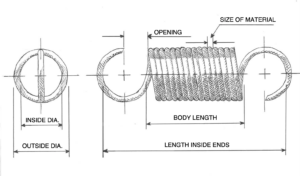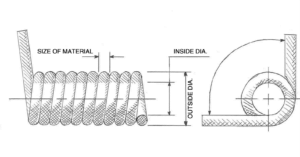How to Prevent a Custom Spring from Becoming Overstressed
Is your spring at risk of failing due to being overstressed?
By definition, springs are designed to take on a considerable amount of stress. When the spring is used in its intended application, it takes on stress anytime it’s extended or compressed.
As long as the force exerted on the spring is within its elastic range, it should function just fine. But if the spring is under too much stress, it will deform outside of the elastic range and experience plastic deformation. The spring will become permanently deformed and never return to its original shape. When this happens we say that the spring has taken a “set”.
So if you design a spring to compress (or extend) slightly and you compress (or extend) it too significantly, it may never return to its designed height. Some springs are designed to be overstressed and have this factored in, or are never compressed to the point where the spring begins to take a set. If the spring permanently deforms you’ll have a completely different spring that may not function properly, resulting in a risk of application failure that can be costly and even dangerous. A spring that is overstressed and takes a set will not function the same and is often at risk for failure from fatigue.
Fortunately, the team at Gifford Spring has the knowledge to destress your custom springs and prevent spring failure from occurring.
How Gifford Spring Prevents Springs from Becoming Overstressed
To prevent a spring from becoming overstressed, we first need to know the spring’s functionality and how much it will extend or compress in its end use application.
This information helps us determine if the spring is at risk of plastic deformation. For example, if your spring hits plastic deformation at 75% extension or compression, but you only need it to perform at 25%, too much stress may not even be an issue. It is important to consider how far the spring will compress at all stages, from manufacturing, to the assembly process, then functioning within a final product.
If you don’t know your spring’s degree of extension or compression, we can evaluate your spring design to check for stress at multiple compressed or extended lengths.
If we find that your spring is at risk of plastic deformation, there are several approaches we can take to improve functionality.
Changing the design

Optimizing the spring design is usually the easiest way to prevent too much stress. Sometimes springs aren’t allocated enough space in the design. Other times, the spring itself is the problem.
Typically, we can modify any of these spring characteristics to reduce stress:
- Length: the length of spring in its natural, coiled form
- Size of material: the diameter of the cross section of the spring wire
- Outer diameter: the farthest, outside points on the coils of the spring
- Total number of coils: the amount of times the spring wraps around
- Envelope: the space in the container that the spring must fit in
Using a different material

Another option is to make the wire itself weaker. Ironically, when you weaken a spring, it actually handles stress better. It’s looser and less locked in, which provides a greater elastic range.
But if you need the spring to be more resistant, the wire should remain thicker, and therefore stronger. Finding the right wire size is a balance between strength and elasticity.
We may suggest changing the spring material to something more ductile that will better equip the spring to handle stress.
Presetting

We can even prevent unanticipated plastic deformation by intentionally inducing it before a spring is used in the field. This process may sound counterintuitive. But taking the spring to full compression or extension a couple of times until it hits plastic deformation actually prevents it from ever deforming again.
Inducing plastic deformation will change the shape of the spring. But since we know the dimensions our customers need after presetting, we can work backwards to get the spring into the right shape.
Since presetting is a manual process, it’s best used for spring prototyping. In a low-volume production setting, we’d typically recommend design changes instead.
Heat treating
We always heat treat springs after forming them to reduce stress. We place the spring in a high-heat oven for a specific amount of time depending on the material used, then allow it to slowly cool.
Ultimately, we recommend designing a custom spring before designing an entire product. But if you need to optimize a spring design to overcome stress later in the process, the team at Gifford Spring is here to help!
Request a quote today to get the best possible custom springs for your applications!